
Stevie Wonder mastered Motown's distinctive fusion of pop and soul and went on to compose far more idiosyncratic music, an ambitious hybrid of sophisticated Tin Pan Alley chord changes and R&B energy, infected with jazz, reggae, and African Rhythms.
Stevie Wonder

Stevie Wonder mastered Motown's distinctive fusion of pop and
soul and went on to compose far more idiosyncratic music, an
ambitious hybrid of sophisticated Tin Pan Alley chord changes and
R&B energy, infected with jazz, reggae, and African Rhythms.
|
|
|
The second son of Calvin and Lula Mae Judkins, Steveland Morris was born May 13, 1950 in Saginaw, Michigan. At various times Wonder's surname can be founded as Judkins, Hardaway or Morris. Though Morris appears on his birth certificate, it never has been properly explained who Morris was. It has been speculated that Morris was an old family name.
Lula Mae's was a daughter of an unwed mother. She was abandoned before her birth by her father Noble Hardaway. Two weeks later in the winter of 1943, she was sent to East Chicago, Indiana where she was raised by her aunt and uncle, Henry and Virgie Wright. Ironically in 1948 she became pregnant by a man named Paul Hardaway. The result was a baby who she named Milton. After the death Henry, Virgie and death of their son John, she was sent to live with her father Noble. When that didn't work out she was sent to Chicago, Illinois to live with her aunt and uncle.
Ironically in 1948 she became pregnant by a man named Paul Hardaway. The result was baby that she named Milton. At this time she was sent to live with a relative in Saginaw, MI. There she met a chronically unemployed, street hustler, gambler, drunk named Calvin Judkins whom she became pregnant by. By mid-1949 came the birth of her second son, Calvin Judkins Jr.
While in Saginaw Calvin would take a job in a furniture store, one that didn't last long. Soon he was back to his old ways.
Late in 1949, Lula became pregnant with Stevie. A troubled pregnancy, Stevie was born two months premature. Though the doctors didn't know it, Stevie lost his vision mere hours after birth. It seems that after being placed in an incubator, given too much oxygen, that caused permanent sight loss. This condition is known as retin-opathy of prematurity. He was the incubator for forty days before being taken home on the fifty-fourth day.
In the spring of 1953 the family moved to Detroit and into 2701 Hastings, a three bed-room flat in the Brewster-Douglas projects. In order top pay the $100 rent, Lula worked at a local fish market. There she would work from midnight to dawn, then overtime to mid-afternoon.. They would move to three bedroom flat on Horton Street. At this time Stevie began Bagley Elementary School which had special classes for blind students.
The Judkins were a musical family. Calvin, a frustrated musician, would teach Stevie songs, buy him a cheap set of bongos, plastic harmonica and and toy piano. Lula always had the radio on to WCHB the first Black owned radio station.. in the United States. A neighbor woman at 2701 Hastings had a piano she allowed Stevie to use. A barber on the block gave him Hohner harmonica. The local Lions Club at a Christmas party for blind children gave him a drum set.
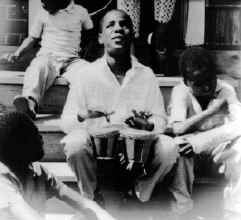
Playing the harmonica at five, he started piano lessons at six and took up the drums at eight. Lula Mae was afraid to let the young boy out of house. Thus a brilliant musical career was launched. To pass the time of day, Wonder would beat on pot, pans,and any other surface that helped him keep rhythm with the tunes he heard on the radio. As he became proficient on various real instruments, he started playing and singing in the choir at the White Stone Baptist Church every Sunday. Kim Weston would claim that the church was actually New Corinthian Baptist. Stevie soon grew to be something of a neighborhood sensation.
When Stevie turned ten, the family moved to bought a modest four bedroom house at 3347 Breckenridge for $8000 with a $800 down payment. There he began attending attending the Fitzgerald School for the Blind where he learned and mastered Braille. During this time he had meet a neighborhood kid name John Glover, a son of one Lula's friend Ruth. Glover who played the guitar with Wonder on the harmonic, formed a trio calling themselves Stevie and John. It just so happened that Glover's cousin, Ronnie White was one of Smokey Robinson's Miracles. In June, 1961 Glover made arrangements to meet at White's house to play a few songs for him. When they arrived not only was White there, but fellow Miracle Bobby Rogers too. They played Lonely Boy, a song Stevie had written, with Stevie singing and Glover accompanying on acoustic guitar.
|
|
|
Auditions at Motown worked that you usually had go to a lower level or two before one got to see Gordy. There are several difference versions of who were took and were involved in arranging Stevie's arranging initial audition. One was White took Stevie and John to Motown the next day. September 23, 1961, along with Lula and Milton Hardaway. White first took him to Brian Holland. Another was an impressed Holland that sent him to Mickey Stevenson Motown's A& R man. Another as Stevenson remembers it, was Clarence Paul his assistant that brought him in. Janie Bradford attests to that too saying " Stevie was out on the front lawn with his mother and Clarence Paul. That was before he signed with Motown, before he ever auditioned. I'm sure Clarence was in position to bring Stevie in."
|
|
Stevenson brought him to Gordy where he sang, played the bongos and harmonica. Gordy envisioning another Ray Charles offered him a contract. Now we are told again two different stories. The first was that Lula Mae, turned off by Mickey Stevenson, claimed he tried to rush her into signing the standard five year contract. Her real objection to the contract was the small salary salary, Motown's normally paid it's performers $200 a week. If under twenty-one an even a less formal $200 a month out of Gordy's pocket. However the biggest reason was under aged Stevie's royalties due would be held in a trust controlled by Motown until he turned twenty-one. Lula Mae left leaving the contract unsigned. Stevenson claimed that she was upset that contract wasn't ready fast enough.
For whatever reason Lula returned and after agreeing to a have a $200 monthly salary, this amount would not increase until the mid-60s, paid directly to her, Lula signed the contract. Stevie signed his X under the typed-in name of Steveland Morris. It has been reasoned that it was to put a legal wall should Calvin Sr. ever try to claim any of Stevie's future earnings.
There are multiple versions of how Stevie got the stage name Stevie Wonder. The first was Gordy after seeing Steve perform one day in the studio exclaimed "That boy is a wonder" and the name stuck Another version is that one day Paul was talking with Stevenson. Stevenson: We can't keep calling him the eighth wonder of the world. Paul: How about Stevie Wonder? Stevenson: Why don't we call him "The Wonder Kid." Paul: Wonder Boy? Stevenson: There's already a Wonder Boy and Batman got him. Paul: Stevie the Wonder Boy. Stevenson: Sounds like a circus act. Paul: Maybe we should keep calling him little Stevie Stevenson: How about Little Stevie Wonder?
|
|
His first album, Little Stevie Wonder the 12 Year Old Genius made the child a huge star, and gave Stevie a number one hit with single "Fingertips," #1 pop and R&B hit. The following year he enrolled in the Michigan School for the Blind where he studied classical piano.

During the childhood stage of his career, Stevie amazed audiences with his exciting performances and continued hitting the charts with such singles as "Hey Harmonica Man," "Work Out Stevie, Work Out," and "Contract On Love" to name a few. In 1964 Wonder dropped the "Little" appellation. His late teen years saw continued success with "Uptight (Everything's Alright)," " For Once in My Life," "My Cherie Amour," and "Signed, Sealed, Delivered I'm Yours." Throughout this period Stevie worked on improving his skills as a singer, keyboardist, songwriter, and producer. In fact, he co-wrote most of his singles from 1967 onward, as well as the Smokey Robinson hit "The Tears of a Clown".
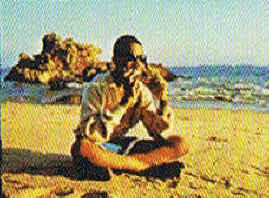
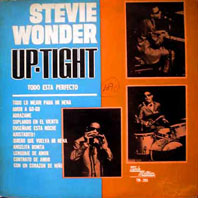
On both his records and live shows he was featured playing harmonica, drums, piano, and organ as well a singing - sometimes all in one number. During his first three years he was presented as a screamer in the Ray Charles mold. In 1964 he appeared on screen in Muscle Beach Party and Bikini Beach. His Up-Tight album included "I Was Born to Love her", "For Once in My Life", and Shoo-Be-Doo-Be Doo-Da-Day". Wonder's style broadened to include Bob Dylan's "Blowing in the Wind" "A Place in the Sun," and an instrumental version of Burt Bacharach's "Alfie". In 1969 he had hits with ballads "My Cherie Amour" and "Yester-Me, Yester-You, and Yesterday".
|
|
Once Stevie turned the age of 21 in 1971, he
didn't immediately resign with Motown. Now able to draw funds
from his trust fund, he invested in his own publishing
(Black Bull Music) and recording studio, Taurus Productions, (
where he could finance his own recordings. Stevie also took some
music theory classes at USC to improve his song writing
capabilities. Stevie recorded two albums on his own ( Where I'm
Coming From and Music of My Mind) with the programming aid of
Robert Margouleff and Malcolm Cecil. Margouleff and Cecil helped
Stevie pioneer the use of synthesizers in popular music (most
notably in Music of My Mind.) With these two albums, Stevie
negotiated a contract with Motown that allowed him more freedom
in artistic matters and a higher royalty percentage.
fund, he invested in his own publishing
(Black Bull Music) and recording studio, Taurus Productions, (
where he could finance his own recordings. Stevie also took some
music theory classes at USC to improve his song writing
capabilities. Stevie recorded two albums on his own ( Where I'm
Coming From and Music of My Mind) with the programming aid of
Robert Margouleff and Malcolm Cecil. Margouleff and Cecil helped
Stevie pioneer the use of synthesizers in popular music (most
notably in Music of My Mind.) With these two albums, Stevie
negotiated a contract with Motown that allowed him more freedom
in artistic matters and a higher royalty percentage.
Stevie signed for five years with $1 million given as an advance against future royalties, complete control over what he recorded, won back half of the publishing royalties of all previous work as well as future work, in addition to 12% on royalties from sales. However Gordy would retain control of the single releases. Such a contract was nearly unheard of then, since Motown had a reputation of being merely a hit-making machine with little variety. Once the new contract was signed, Stevie released the two albums. Although the albums were not huge successes, Stevie showed signs of the genius that was about to come.
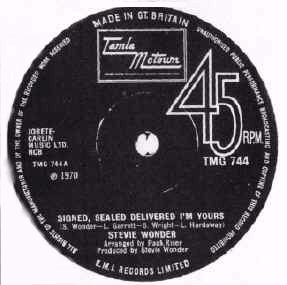
By the time of "Signed, Sealed, Delivered," he was serving as his own producer and arranger, playing most of the instruments and writing material with his wife Syreeta Wright. During this time he had hits with "Signed, Sealed, Delivered I'm Yours", Heaven Help Us All', and "If You Really Love Me". His singles upheld Motown's tradition of hook happy radio fare, but distinguished themselves with socially conscious subjects such as ghetto hardship and political disenfranchisement. His albums, beginning with Music on My Mind, on which he played most of the instruments, were devoted to his more exotic musical ideas.
|
|
|
Wonder's 1972 tour with the Rolling Stones introduced him to a huge white audience, which helped make #1 hits of two singles "Superstition" and "You Are My Sunshine" released within the next year. This period was difficult for Wonder with his marriage to Wright ending after only a year. Injuries sustained in a serious car crash in 1973 left him in a coma for four days and a lost sense of smell. In the next four years, Wonder had three #1 singles("You Haven't Done Nothin'", "I Wish", and "Sir Duke"), sold millions of each, and received 15 Grammies. His songs were covered widely and he was acknowledged as an influence on musicians from Jeff Beck to George Benson to Bob Marley. Working with B.B. King, the Jacksons, Minnie Riperton, and Syreeta Wright, he established himself as a major songwriter and producer. His Songs In the Key of Life album was a tour de force and remained at the top of the charts for 14 weeks
|
|
|
.In late 1972 Stevie began his string of
critically acclaimed and Grammy winning albums with Talking
Book. This album brought Stevie out from the mini-slump he
had been suffering 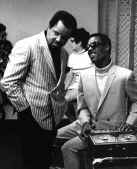 through chart-wise with two number one
hits, the funky "Superstition" and the now standard
"You are the Sunshine of My Life." The album was a big
hit with the public. The power and emotion of the album in many
ways shone true because many of the songs ("Blame It on the
Sun," " Looking For a New Love," " I
Believe") were written in reference to the relationship with
his wife and former musical partner Syretta Wright. The
programming of Margouleff and Cecil helped to represent these
feelings in an all new manner.
through chart-wise with two number one
hits, the funky "Superstition" and the now standard
"You are the Sunshine of My Life." The album was a big
hit with the public. The power and emotion of the album in many
ways shone true because many of the songs ("Blame It on the
Sun," " Looking For a New Love," " I
Believe") were written in reference to the relationship with
his wife and former musical partner Syretta Wright. The
programming of Margouleff and Cecil helped to represent these
feelings in an all new manner.
Less than a year later Stevie released the now classic Innervisions featuring the hits "Living For the City" and "Higher Ground." The former Living is perhaps the most dramatic and inspiring song Stevie has ever written. This song, along with many Marvin Gaye classics from What's Going On helped soul music adequately face and question the prevailing racial problems and inadequacies. Higher Ground (maybe the best Red Hot Chili Pepper funk-out) along with Jesus Children of America allowed Stevie to express his spirituality and love for God unlike ever before. The album was full of other powerful tunes like "Too High" and "He's Mistra Know-It-All" which are about drug abuse and gangsters/players, respectively. Innervisions is regarded by many as the high mark of Stevie's craft; it was the album he was meant to make for the world.

His next album, Fulfillingness' First Finale
(1974) expressed this new sense of life musically. The album did
have its share of variety, such as the anti-Nixon funk anthem You
Haven't Done Nothin' and the happy Boogie on Reggae Woman.
However, the album was on the whole more introspective and
life-affirming than his previous albums.
Throughout this period, Stevie Wonder nearly swept all possible
Grammys he was eligible for. Winning for Best R & B Artist,
Best Album, Best Song, Best Male Vocal, etc., Stevie amassed
numerous awards and was recently awarded the Grammy's Lifetime
Achievement Award. While in-between albums in 1976, Paul Simon in
his acceptance speech for winning the Album of the Year Grammy
jokingly thanked Stevie Wonder for not releasing an album that
year. Stevie in fact did not release an album during that period
because he was working on what would be his masterpiece double
album entitled Songs in the Key of Life, released in
1976. This album runs the gamut of different musical styles, from
the baroque classical in "Village Ghetto Land" to the
gospel soul of "As," the fusion jazz of
"Contusion" to the Middle-East influenced "Pastime
Paradise," and the boogie-woogie jazz of "Sir
Duke" to the all-out funk of "I Wish." Lyrical
content also varied, covering such wide topics as racism &
Black History ("Pastime Paradise,' " Black Man"),
the passing of time ("I Wish, Summer Soft), child adoration
(Isn't She Lovely), and of course love (As, Knocks Me Off My
Feet.) If any Wonder album is a classic, it is Songs.

Journey Through the Secret Life of Plants, three years in the making, was predominantly instrumental, failed to catch on. Mostly instrumental, the album didn't fair as well as previous Wonder albums, although it did sport the hit "Send One Your Love." The movie accompanying the soundtrack was never completed. Despite the lukewarm response of the album, it did serve as a precursor to new age music of the 1980's. Motown felt after this project that caution should be used when releasing new material. This attitude led to albums being released less frequently than before; his first album of new soul material was Hotter Than July Hotter Than July returned to the street dancing spirit of Wonder's earlier years. 1982 saw hit singles with "That Girl", "Do I Do", a duet with Paul McCartney "Ebony and Ivory," and a greatest hits album Stevie Wonder's Original Musiquarium.
During the 1980's Stevie Wonder entered a phase
of his career which was perhaps his most successful commercially.
However, critics panned most of his work in this period, stating
that it failed to live up to his previous outings. During this
time, Stevie seemed more interested in making music for people
rather than for himself or other reasons. Hits like "Ebony
and Ivory," " I Just Called to Say I Love You,"
" Part Time Lover," " Overjoyed," and
"That's What Friends are For" reflected this feeling.
Stevie didn't stop helping others through his music and
activities, however. He fought against drunk driving, apartheid
in South Africa, and hunger in Ethiopia through song. His
mini-duet with Bruce Springsteen in the benefit song "We are
the World" remains as one of the weirdest yet most powerful
and memorable musical exchanges ever.
Wonder cut down on recording, but continued to tour. In 1982 ,
with Bob Dylan and Jackson Browne, he played the "Peace
Sunday" anti-nuclear rally at the Rose Bowl. In 1984 Detroit
gave him the key to the city and he played the harmonica on Elton
John's "I Guess That's Why They Call It the Blues" In
1985 he participated in the recording of USA for Africa's
"We Are the World and won that year's Oscar for Best Song
for "I Just Called to Say I Love You" off the Woman
in Red soundtrack.

1985's "Part Time Lover" became the first single to simultaneously to top the pop, R&B, adult contemporary and dance.disco charts; its parent album In Square Circle, reached #5 and won the Grammy for Best Male Vocal Performance. Wonder had another 31 singing with Elton John and Gladys Knight on Dionne Warwick's "That's What Friends Are For".
In 1987, the album Characters saw a return for Wonder to the funkiness he's always been known for with songs like "Skeletons" and "Get It"
|
|
The late Eighties were spent working on Conversation Piece, which was released to rave reviews. 1988 duets with Michael Jackson ("Get It") and Julio Iglesias ("My Love") kept Wonder's name before the public. He was inducted into the Rock and Roll Hall of Fame in 1989. His extensive humanitarian work has included AIDS awareness, anti-apartheid efforts, crusades against drunk driving and drug abuse, and fund raising for the blind and retarded children and the homeless.
Throughout the 90's, Stevie has continued making
important music. He composed and performed the soundtrack for the
Spike Lee's Jungle Fever (1991). His 1994 album Conversation
Peace, eight years in the making, but was well worth the
wait. It was Stevie back in vintage form; beautiful, catchy
melodies intermixed with meaningful lyrics and funky rhythms. For Your
Love won two Grammys at the 1996 Grammy Awards for Best R
& B Song and Best R & B Male vocal. That year the Grammy
people awarded Stevie the Lifetime Achievement Award due to his
outstanding musical career not to mention his numerous Grammy
wins. D'Angelo and Tony Rich performed an outstanding Wonder
medley to commemorate the event. And despite a somewhat
unfortunate absence from the top of the U.S. charts throughout
the nineties, Stevie has still remained visible in the public
eye, with performances at Bob Dylan's 30th Anniversary Tribute in
1992 ("Blowin' in the Wind"), at the Rock and Roll Hall
of Fame Inductions, and at the closing ceremonies of the 1996
Atlanta Summer Olympics where he performed "Happy
Birthday" with Gloria Stefan, Trice Yearned, Al Green and
others with slightly-changed lyrics to celebrate the modern
Olympiad's centennial birthday.
funky rhythms. For Your
Love won two Grammys at the 1996 Grammy Awards for Best R
& B Song and Best R & B Male vocal. That year the Grammy
people awarded Stevie the Lifetime Achievement Award due to his
outstanding musical career not to mention his numerous Grammy
wins. D'Angelo and Tony Rich performed an outstanding Wonder
medley to commemorate the event. And despite a somewhat
unfortunate absence from the top of the U.S. charts throughout
the nineties, Stevie has still remained visible in the public
eye, with performances at Bob Dylan's 30th Anniversary Tribute in
1992 ("Blowin' in the Wind"), at the Rock and Roll Hall
of Fame Inductions, and at the closing ceremonies of the 1996
Atlanta Summer Olympics where he performed "Happy
Birthday" with Gloria Stefan, Trice Yearned, Al Green and
others with slightly-changed lyrics to celebrate the modern
Olympiad's centennial birthday.
Wonder's long career has been remarkable not just for his musical genius, but for his persistence in overcoming obstacles-most notably his blindness-that have stood in his way. Witness his participation at a charity auction: he drove James Bond's BMW Roadster onstage to help auction it off.
Wonder was awarded the Grammy's Lifetime
Achievement Award in 1996 and was inducted into the Rock and
Roll Hall of Fame in 1989.
![]()